DevCon Secrets # 2. How the conference grid is formed
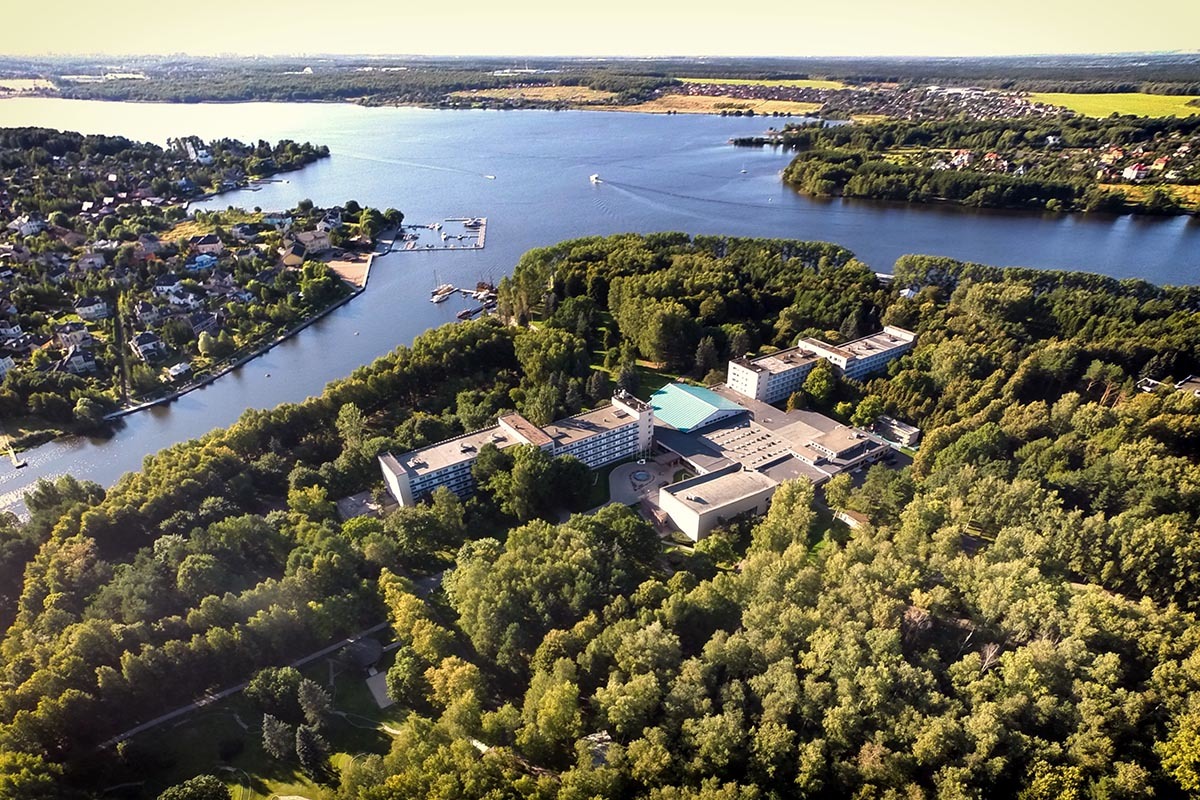
We continue to talk about how to create our traditional conference for developers - DevCon . In the last article, we shared a story about how the conference format is being updated, taking into account feedback from participants in past years. Today we will talk about how the conference grid is being formed - an hourly and even per-minute scheme of the event, which takes into account various parallel activities, including, of course, the conference's content program.
More precisely, we begin to tell, because this topic will consist of two parts:
- The first part, devoted mainly to organizational issues, is what you are reading right now.
- The second part, which tells about the conference program, will be released in the spring.
')
Start with limitations
Important framework
One of the logistical tasks that we solved when planning the new DevCon was to move the conference closer to Moscow. We still wanted to spend it out of town, but so that the participants did not have much difficulty to reach by car, and the transportation time from the nearest metro took as little time as possible.
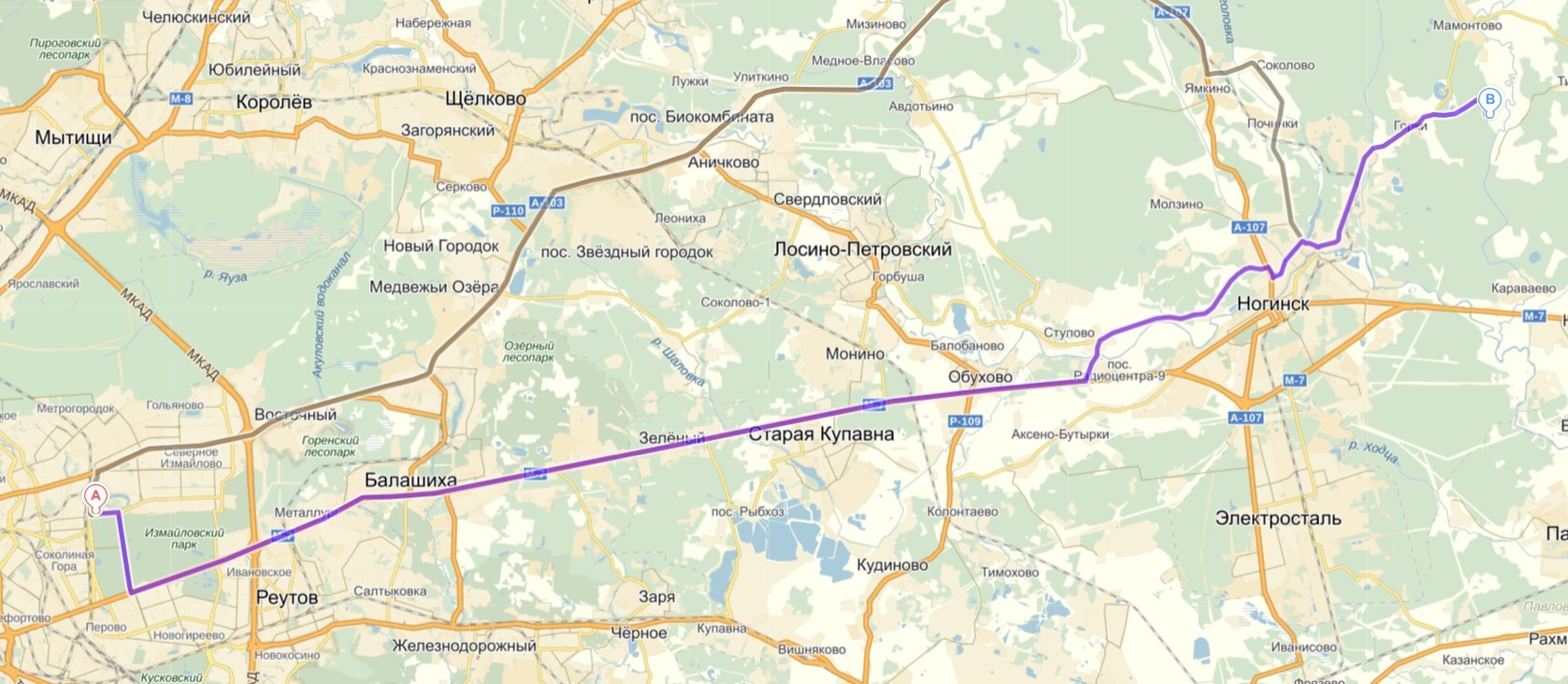
The route to the previous venue: 60+ km, 1.5+ h (Yandex.Maps)
For comparison: in past years, the bus from the metro to the venue drove about an hour and a half, and if there were traffic jams, then all two - two and a half. As a result, the traditional beginning of the conference was not at 10 am, but at 11 am, and in order to have time to deliver all the participants, we started sending buses from 7 am. In this case, we usually lay time with a margin, for example, in this case the “transportation window” is four hours.
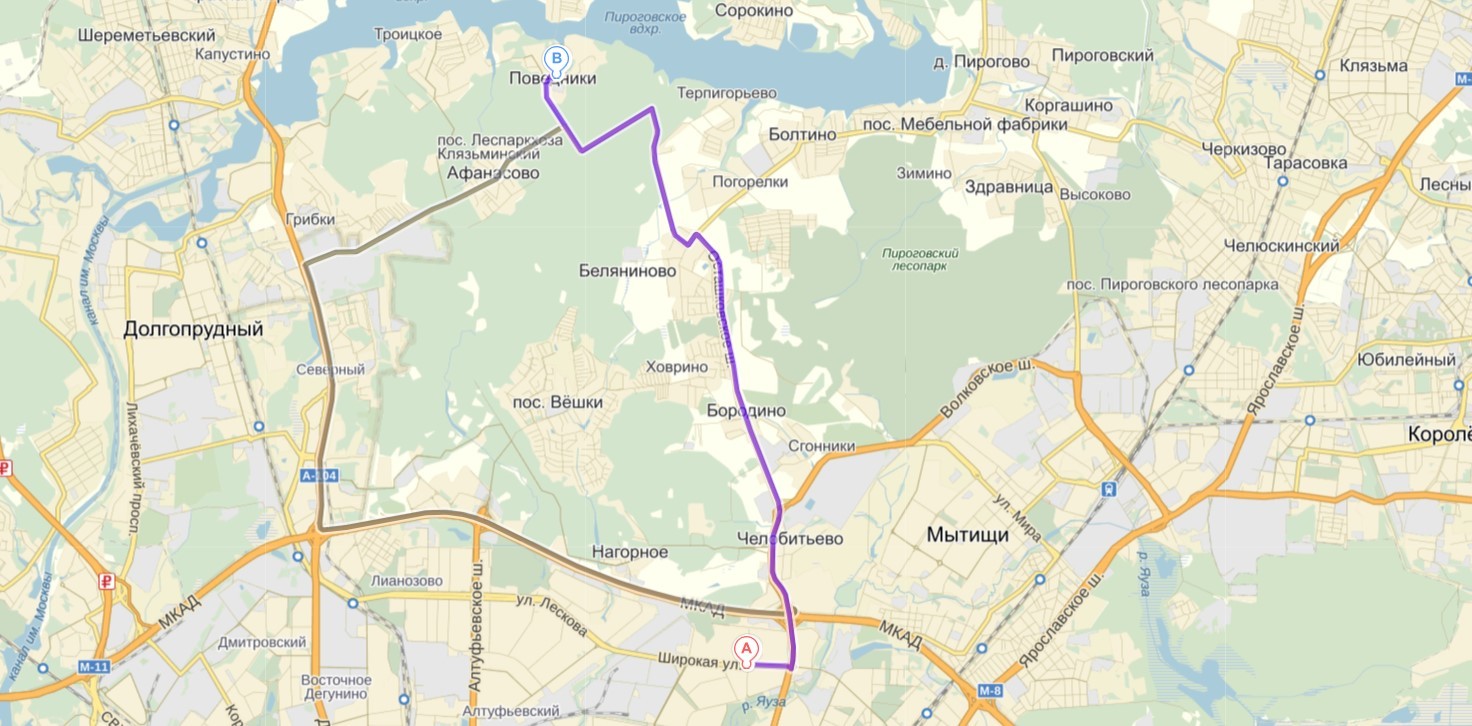
The route to the new venue: 15+ km, 30+ min. (Yandex maps)
The new DevCon will be held in the Klyazma boarding house on the Klyazma reservoir - water, trees, squirrels. The new place gives its advantages and also imposes its own limitations.
From the point of view of the program of the event, saving on distance and transport time in one direction is essential. Now we not only give participants the opportunity to sleep more (or a larger buffer for flights / transfers, which is critical for participants not from Moscow), but we can start the conference itself earlier, and therefore potentially tell more interesting things.
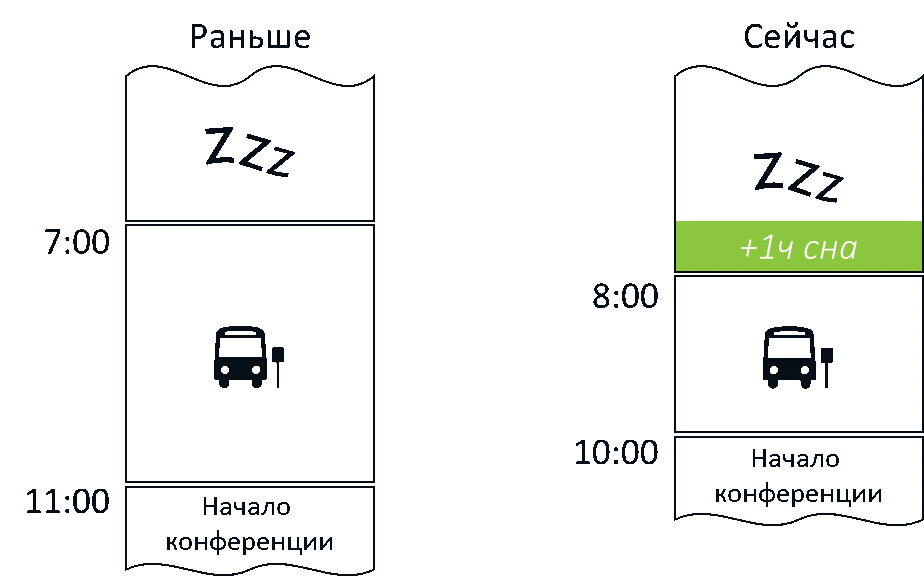
A similar “saving” of time is obtained with the departure at the end of the first or second day - you can leave later, and travel time will be less.
Why did we start our story with transport? Because before we can form the internal grid of the event, it is important for us to understand what limitations we have. The time of the beginning and end of the conference is the framework into which you need to fit.
Geometry of space and time
The second important point is what restrictions are imposed on the territory of the boarding house and the location of various zones.

Potential zones for various activities on the territory of the boarding house (Yandex.Maps)
When designing an event program, it is important to understand many different parameters, including:
- How long does the unhurried (good, large territory, paths and “dense forest” contribute to this) transition between different zones? For example, I am in the main building (1) and I want to walk to the marina to the exhibition area (2) and then have time to return to the next report (1). You can, of course, measure with a ruler on the map, but it is important to walk with your feet with a stopwatch.
- What are the durations of taking breaks? Participants need to have time (perhaps not all at once) to communicate, watch the exhibition, walk to another zone, have a snack, drink, or, trivially, walk to the nearest toilet (this is also important!). Here again it is necessary to understand the geometry of the territory.
- How long does it take breakfast, lunch and dinner? Moreover, it is important to understand not only how much to go to the restaurant from different places, but how many people can stay comfortably at the same time and how much the restaurant service is ready to serve such a number of people in parallel (for example, can the kitchen serve hot meals in a timely manner). Still, for example, it is worth finding out what the minimum time between different “food sessions” can be, for example, between breakfast and lunch, or between lunch and the nearest “tea, coffee, cookies” break.
- When can I check in the rooms and when should I check out? This concerns, first of all, those participants who come to the entire conference, that is, for two days. We must be sure that there is enough time outside the content part of the conference to do these operations. Along the way, you need to make sure that the boarding house accommodation service is ready to populate people at the right speed (this is also not easy, given that this moment does not depend on us much).
Therefore, our traditional exercise is a large team of organizers to come to a potential site and, in addition to other organizational and technical issues, find out all the logistical issues.

So, in October we came to Klyazma and walked between all the main zones to find out where there are parking lots, where there is a restaurant, where each hall, where the smoking area (Health Ministry warns!), Etc.
When preparing a breakdown by time, we try to make all the blocks multiple to 15 minutes (it is easier to enter in the time grid). With such a cell, we define "internal" blocks:
- 30 minutes for a break,
- 1.5 hours for lunch and quiet dinner,
- 1 hour for breakfast.
We check the hands of the clock
Ultimately, you have a list of questions that need to be answered. For example, it might look like this:
If the conference is held within the city, it is important to know the time on foot from the nearest metro or major transportation hub. If the site is on the outskirts of the city, you need to consider the time from the center (or the metro line in Moscow).
There are all sorts of interesting parameters that many organizers do not think about (or, unfortunately, they can’t do anything with them). Say, the noise of the corridors, which means that there is a need to find a “quiet zone”, or, if the conference takes place during the cold season, the speed of service in the wardrobe.
Depending on the configuration of the site and the number of participants, specific numbers may be reduced or increased. For example, the time for lunch is highly dependent on the number of participants and the capacity of the restaurant. And the time for breaks is from the proximity of the conference halls and the conscience of the organizers.
From our experience of participating in different conferences and holding our own, we know that different organizers relate to all these parameters differently. Usually, the need to clarify them comes with experience. For a familiar site, key indicators may be known.
In general, if the content component (we will talk about it below) is the time to gain knowledge, then such “internal sections” is time for a comfortable stay at the conference, which is equally important as it is part of the overall impression.
One of the first outline of the event grid
Large blocks are easily distributed across the time grid (I use Excel) and can already be used independently for planning the transportation and feeding of participants. They act as constraints for the content component.
By agreeing at an early stage, we can largely dissolve the work of the content team and the rest of the conference preparation team.
Time scale
An interesting point about the time scale: when planning the overall structure of the event, the key task is to tie together different blocks. Although it is possible to introduce minute-by-minute timing, usually a step of 15, 20 or 30 minutes is enough - such relatively large blocks are convenient for perception and fitting to “round” values.
Having agreed at the top level, you can already dive into the details: now each specific activity can be split up in accordance with a convenient time scale for it.
For example, the available one and a half to two hours for transportation of participants to the boarding house easily fight for 10-minute bus departure times, which are later published on the site as a schedule.
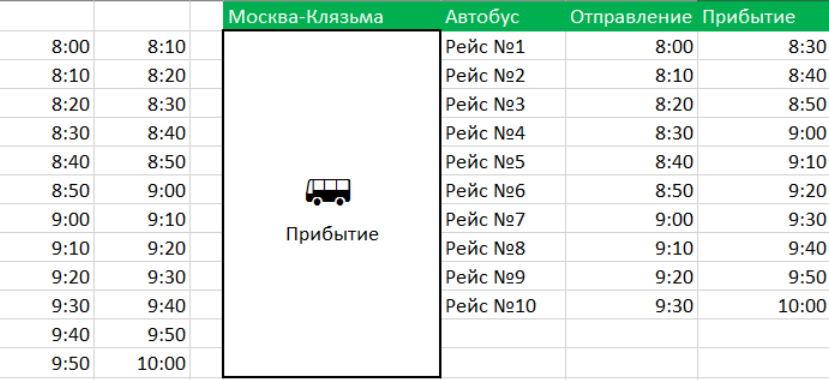
Draft version of the bus schedule
And in the case of lunch, the people responsible for food, in their version of the program will lay the time to prepare and clean the restaurant (this is the answer to the question of the minimum time between power supplies):
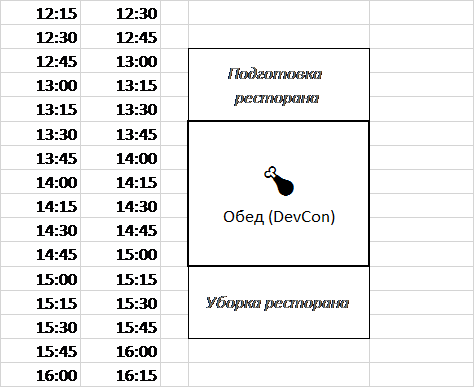
Lunch box in the internal program of the event
Similarly, for the reports, each specific speaker builds up the internal timing of his speech with a rhythm convenient for him.
Fill with content
It's time to go to the content of the conference. Perhaps you are wondering: why do we first discuss some organizational issues, logistics, time for dashes, etc., and not reports. There are several natural reasons for this.
Divide and rule
First, it is important to understand how the person responsible for the track or, in general, the content of the conference works. For example, at the initial stage, we decided that the conference had three big themes consistent with the company's strategy:
- Windows 10 and Universal Windows Platform (UWP)
- Microsoft Office and Productivity
- Microsoft Azure and smart cloud platform
Each topic has its own responsible. We give them equal priority. The first question asked by those responsible for the tracks is: “How many reports do I have”? To answer this question, you must first, in some approximation, design the entire grid of the event.
Knowing this limitation, the person responsible for the track begins to select speakers and reports in accordance with his vision of how the track should look.
Working in a team, it is important to agree on the shore. Even if you are forming a program individually, it is important for you to understand the overall skeleton of the program before you even call the first speaker. In our case, we agreed that the three thematic tracks of the conference look like this (each):
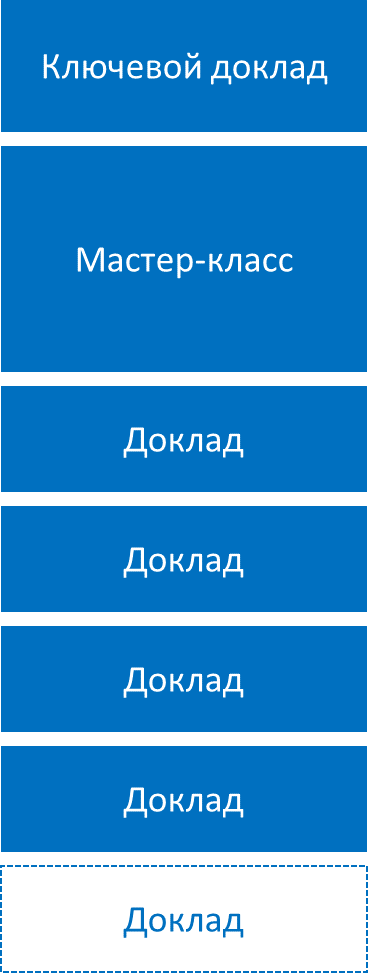
Thematic track structure
In total, this is 5.5+ hours of content for each topic.
In a month, another person responsible for the tracks will start asking the second question: “How long is the report”? In fact, we would start, but we already know everything and said.
Room to room
Secondly, although the report can be read even in a small room in front of the camera and one spectator (cameraman), we are working at the conference for living participants sitting in the hall. In a room of a certain size, a certain capacity, configuration, etc.
As a rule, if the conference venue is a configurable space that is not specially created for this kind of activity, then we need to work with the limitations that we receive by selecting this platform.
It is important for us to use the available rooms as efficiently as possible. For example, we obviously understand that reports are better read to a large audience, and to limit lengthy workshops by the number of participants.

Approximate ratio of halls capacity
In our case, we have a list of halls and their capacity. We also previously looked at all the rooms in person. Based on this information, we can plan in which halls we can conduct:
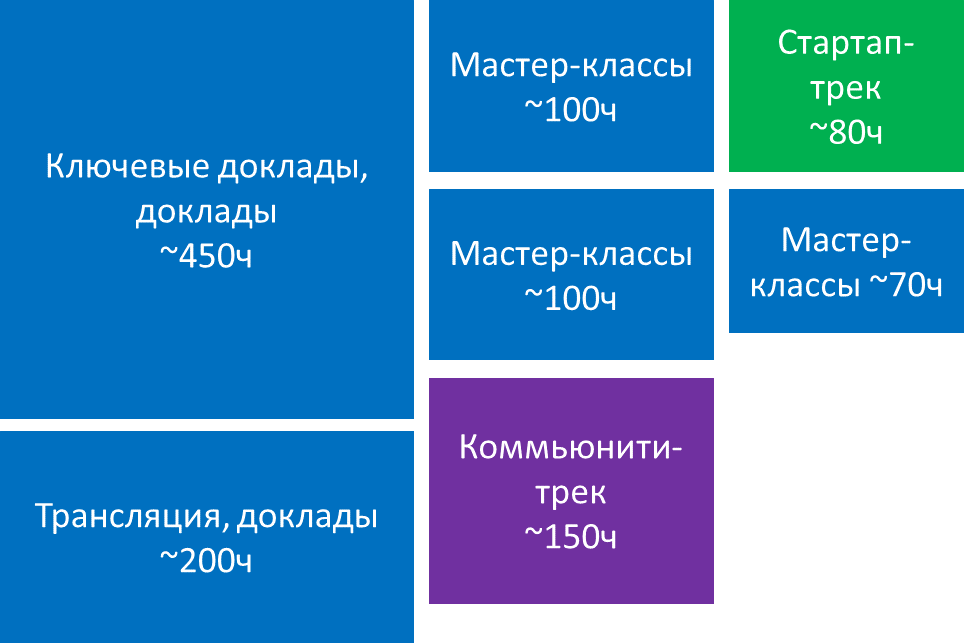
Distribution of halls by content type
Set the rhythm
Thirdly, the conference should have a clear and fairly simple rhythm, helping to navigate the grid of parallel activities. Therefore, in addition to logistic, we will definitely ask ourselves “content” questions about time:
- What is the duration of the report - 20, 30, 45 minutes or an hour?
- How long does it take to lay on
- questions in the report - 5-10 minutes?
- questions after the report (for example, communication on the sidelines) - another 5-10 minutes?
- How much time is required to change the speakers - and another 5-10 minutes?

Empty grid for rhythm
In the simplest version, all activities are fully synchronized and uniform. That is, if a break, then it is at one time at all. If the reports, then all the same in duration and at the same time at all.
In the most difficult and uncomfortable - a bunch of different activities with uncoordinated rhythms.
We need the right balance, taking into account, for example, that different times are ideally suited for different activities - and this time must be entered into the general rhythm of the conference! Here we are trying to attach to a step of 15 minutes.
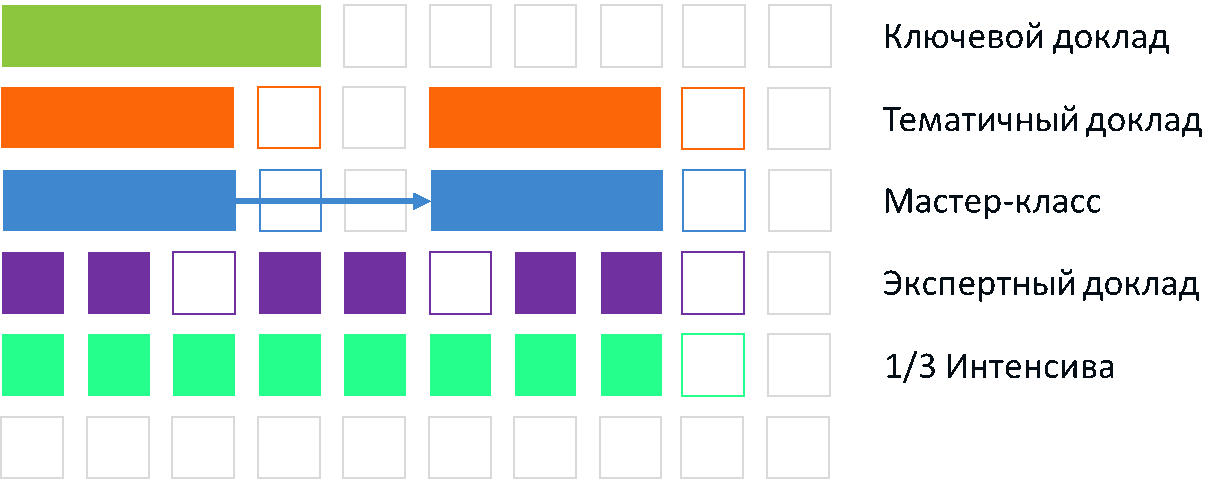
Synchronization of activities for the duration
We consult, take into account our own experience and dynamics of the audience, we are looking for a good combination.
Key reports
These are three important reports that we want to tell the widest possible audience. Their importance is emphasized both by the duration and by the fact that there are no other content activities along with them.
Duration: 4x15 min = 1 hour.
Reports of thematic tracks
Immersion in technology is difficult to do in 20 minutes, but even a whole hour seems to be superfluous by today's standards. For example, we feel this by a young audience. 45 minutes - just right. At the same time, we ask each speaker to necessarily provide within the report 5-10 minutes for questions and answers and communication with the audience. In addition, it will be possible to talk after the report and in the framework of a number of other activities, which we will discuss in other articles.
Duration: 3x15 min = 45 minutes.
Reports of start-up and community tracks
In these tracks, the main task is to share practical experience. The experience fits well with more capacious 30-minute reports. Here we also lay time for questions and answers.
Duration: 2x15 min = 30 minutes.
Master Classes
By the time a master class is a double report: the presenters have two blocks of 45 minutes each and there is a break between them for free communication.
Duration: 6x15 min = 1.5 hours.
Intensives
Structurally intensive are similar to three master classes: these are three blocks of 2 hours each, that is, a total of 6 hours of immersion in technology.
Duration: 3x8x15 min = 6 hours.
Cocktail activities
Fourth, with all the desire, we can not ignore the physiological characteristics of a person. A person needs not only to listen, but also to eat and drink, and sleep, and communicate, and much more. At the same time, the time for absorbing knowledge should be diluted with time for their digestion.
Therefore, first of all, we single out the main rhythm of the conference:

The main rhythm of the conference for the first day

The main rhythm of the conference for the second day
In the basic rhythm, we single out activities that are common to all participants:
- Key reports and discovery
- Time for reports
- Time for food
- Small breaks
In turn, content blocks may have their own rhythms within, depending on the type of content. This issue is solved simultaneously with the determination of the duration of different types of sessions. Moreover, the “imposition” of interruptions is no longer so critical.
As a result, we get approximately the following grid with distribution by halls and by time:

Draft content of the conference content grid (first day)
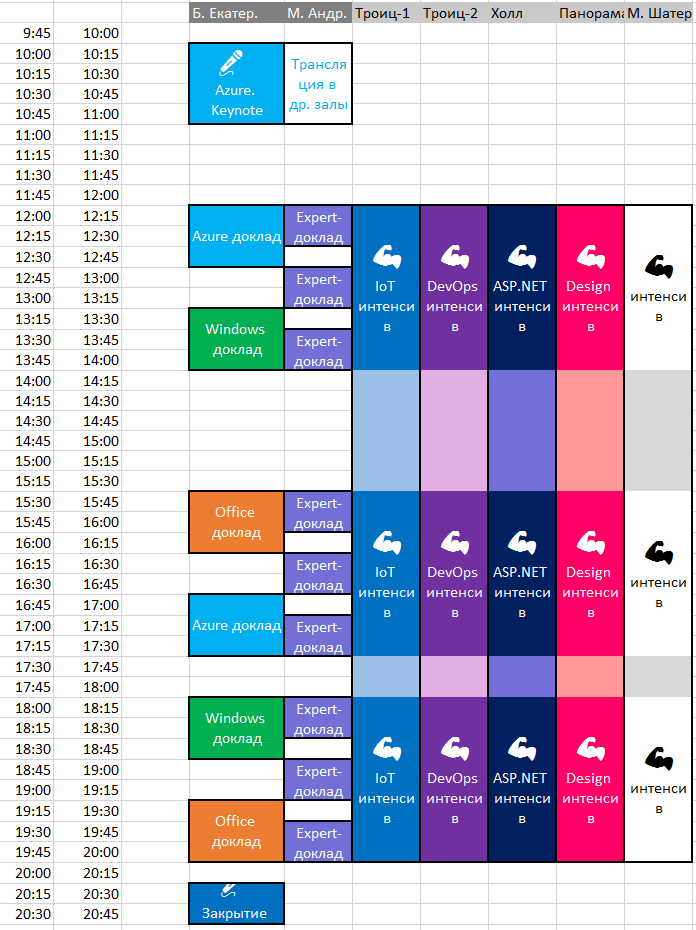
Draft content grid of the conference (second day)
An interesting detail: we try to combine thematic and expert reports in such a way that we can find appropriate activity for each of the conference topics at any time.
The above schedule is not final. In particular, it does not display a number of additional “content” activities, which we will discuss later. We are also thinking about adding a fifth intensive or additional portion of reports.
What's left overs
In addition to the basic rhythm formed by the restrictions, and the content rhythm set by the duration and number of sessions, the conference also has additional rhythms and activities not yet displayed in the program. For example, this is all that concerns the exhibition, special blocks for communication with experts and speakers, as well as evening activities between the first and second days of the conference. We will tell about it in a separate article.
Traditional block about tickets
You can buy DevCon conference tickets on the website: www.msdevcon.ru .
Source: https://habr.com/ru/post/275087/
All Articles